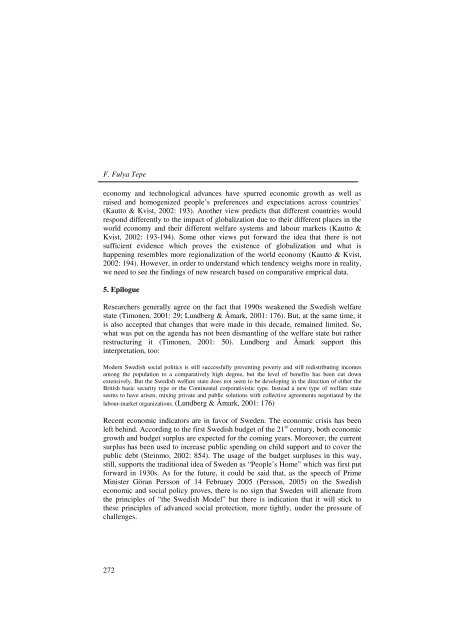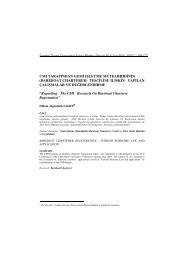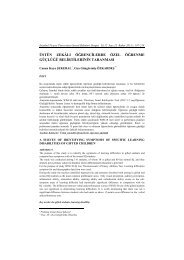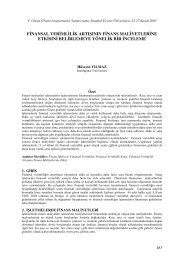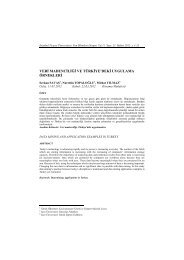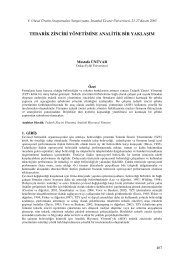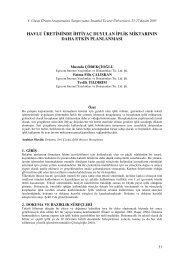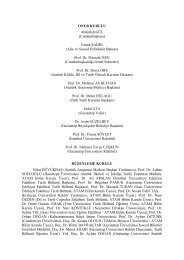an introduction to the swedish welfare state - Ä°stanbul Ticaret ...
an introduction to the swedish welfare state - Ä°stanbul Ticaret ...
an introduction to the swedish welfare state - Ä°stanbul Ticaret ...
You also want an ePaper? Increase the reach of your titles
YUMPU automatically turns print PDFs into web optimized ePapers that Google loves.
F. Fulya Tepeeconomy <strong>an</strong>d technological adv<strong>an</strong>ces have spurred economic growth as well asraised <strong>an</strong>d homogenized people’s preferences <strong>an</strong>d expectations across countries’(Kaut<strong>to</strong> & Kvist, 2002: 193). Ano<strong>the</strong>r view predicts that different countries wouldrespond differently <strong>to</strong> <strong>the</strong> impact of globalization due <strong>to</strong> <strong>the</strong>ir different places in <strong>the</strong>world economy <strong>an</strong>d <strong>the</strong>ir different <strong>welfare</strong> systems <strong>an</strong>d labour markets (Kaut<strong>to</strong> &Kvist, 2002: 193-194). Some o<strong>the</strong>r views put forward <strong>the</strong> idea that <strong>the</strong>re is notsufficient evidence which proves <strong>the</strong> existence of globalization <strong>an</strong>d what ishappening resembles more regionalization of <strong>the</strong> world economy (Kaut<strong>to</strong> & Kvist,2002: 194). However, in order <strong>to</strong> underst<strong>an</strong>d which tendency weighs more in reality,we need <strong>to</strong> see <strong>the</strong> findings of new research based on comparative emprical data.5. EpilogueResearchers generally agree on <strong>the</strong> fact that 1990s weakened <strong>the</strong> Swedish <strong>welfare</strong><strong>state</strong> (Timonen, 2001: 29; Lundberg & Åmark, 2001: 176). But, at <strong>the</strong> same time, itis also accepted that ch<strong>an</strong>ges that were made in this decade, remained limited. So,what was put on <strong>the</strong> agenda has not been dism<strong>an</strong>tling of <strong>the</strong> <strong>welfare</strong> <strong>state</strong> but ra<strong>the</strong>rrestructuring it (Timonen, 2001: 50). Lundberg <strong>an</strong>d Åmark support thisinterpretation, <strong>to</strong>o:Modern Swedish social politics is still successfully preventing poverty <strong>an</strong>d still redistributing incomesamong <strong>the</strong> population <strong>to</strong> a comparatively high degree, but <strong>the</strong> level of benefits has been cut downextensively. But <strong>the</strong> Swedish <strong>welfare</strong> <strong>state</strong> does not seem <strong>to</strong> be developing in <strong>the</strong> direction of ei<strong>the</strong>r <strong>the</strong>British basic security type or <strong>the</strong> Continental corporativistic type. Instead a new type of <strong>welfare</strong> <strong>state</strong>seems <strong>to</strong> have arisen, mixing private <strong>an</strong>d public solutions with collective agreements negotiated by <strong>the</strong>labour-market org<strong>an</strong>izations. (Lundberg & Åmark, 2001: 176)Recent economic indica<strong>to</strong>rs are in favor of Sweden. The economic crisis has beenleft behind. According <strong>to</strong> <strong>the</strong> first Swedish budget of <strong>the</strong> 21 st century, both economicgrowth <strong>an</strong>d budget surplus are expected for <strong>the</strong> coming years. Moreover, <strong>the</strong> currentsurplus has been used <strong>to</strong> increase public spending on child support <strong>an</strong>d <strong>to</strong> cover <strong>the</strong>public debt (Steinmo, 2002: 854). The usage of <strong>the</strong> budget surpluses in this way,still, supports <strong>the</strong> traditional idea of Sweden as “People’s Home” which was first putforward in 1930s. As for <strong>the</strong> future, it could be said that, as <strong>the</strong> speech of PrimeMinister Gör<strong>an</strong> Persson of 14 February 2005 (Persson, 2005) on <strong>the</strong> Swedisheconomic <strong>an</strong>d social policy proves, <strong>the</strong>re is no sign that Sweden will alienate from<strong>the</strong> principles of “<strong>the</strong> Swedish Model” but <strong>the</strong>re is indication that it will stick <strong>to</strong><strong>the</strong>se principles of adv<strong>an</strong>ced social protection, more tightly, under <strong>the</strong> pressure ofchallenges.272


